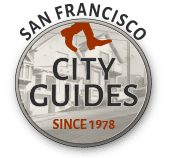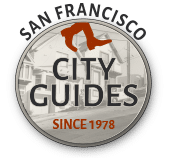San Francisco Tour Tales
Jesse Benton Fremont
She is thought to be the real author behind the successful writings of John C. Fremont (general, senator, presidential candidate, and the Pathfinder of the West) describing his explorations. Jesse Benton Fremont (1824–1902), Fremont’s wife, was also the daughter of Missouri Senator Thomas Hart Benton, a leading advocate of Manifest Destiny, a political movement pushing expansion to the West. And in her event-filled life, some of her happiest times were at her house in San Francisco’s Black Point area, now known as Fort Mason.
The Fremonts lived there between 1860 and 1861. The prop-erty included three sides of the point, and Jesse described it “like being on the bow of a ship.” They had a clear view of the Golden Gate, so named by John when he first viewed it in 1846. Alcatraz was so close that Jesse is said to have called the lighthouse on the island her nightlight.
The Spanish called the area Point San Jose and built a battery in 1797. However, cold winds and fog soon made the cannons useless. By the time the Mexicans were ruling in the 1820s, the area was known as Black Point for the dark vegetation on the land.
Their house was one of six on the point. Jesse remodeled the house and added roses, fuchsias, and walkways on the 13 acres. Their home became a salon for San Francisco intellectuals. Thomas Starr King, the newly appointed minister of the Unitarian church, was a fixture for dinner and tea. Young Bret Harte, whose writing Jesse admired, became a Sunday dinner regular, as did photographer Carleton Watkins. She invited literary celebrities when they came to town—including Herman Melville, who was trying to get over the failure of Moby Dick. Conversations in her salon led to early conservation efforts when Jesse and a group including Watkins, Starr King, Fredrick Law Olmsted, and Israel Ward Raymond lobbied Congress and President Lincoln to preserve Yosemite and Mariposa Big Trees. Jesse’s husband, however, often away on business ventures, was not a regular at her gatherings.
Jesse’s education was unusual for a woman of her time. She accompanied her father to the White House when he visited presidents and spent time at the Library of Congress while he was working in the Senate. In her childhood home she heard William Clark tell stories about his travels with Meriwether Lewis.
The sixteen-year-old Jesse met the handsome and dashing Fremont when he worked at the mapping wing of the United States Army, where her father spent time because of his interest in Western expansion. When her parents noticed Jesse’s interest, they forbade her to see Fremont. After the two eloped, her parents stopped speaking to her, but later reconciled. Thomas Hart Benton then pushed funding for Fremont’s 1842 trip to explore the Oregon Trail.
On returning from Oregon, John Fremont was required to report his findings to Congress, but suffered writer’s block. As Jesse later recalled, “the horseback life, the sleep in the open air” made him “unfit for the indoor life of writing.” She offered to write as he dictated to her, and the report with its descriptions of the western lands was a success. Succeeding expedition reports made Fremont and his scout Kit Carson famous. People heading west for gold bought copies with their supplies. Historians are mixed on who was the actual writer. One, John W. Caughey, indicated that Fremont was one of those writers who “acquired by marriage a very attractive literary style.”
During an 1846 expedition to California, Fremont found himself caught between conflicting orders of feuding Army General Stephen Kearny and Navy Commodore Robert Stockton. He declared himself military governor and was subsequently arrested and court-martialed. In a strange twist of fate, Fremont asked American Consul Thomas Larkin to purchase land in the San Jose area before he left California for his trial. Larkin instead purchased land in Mariposa, where a few years later gold was discovered, making the Fremonts very rich.
When Fremont lost his trial, he left the Army and headed west on another expedition. Just as the discovery of gold was announced, Jesse traveled to California to meet him, using the Isthmus of Panama route. This was something very few women did–even fewer with only a six-year-old child, her daughter Lily, as a companion. Fremont tended his business at the mines in Mariposa, and the Fremonts lived in Monterey, Bear Valley, and San Francisco at periods between 1849 and 1861. Fremont bought the house at Black Point in 1860 for $42,000.
When civil war seemed likely, the Fremont family returned east for John’s new Army appointment, which lasted only a few months. (He decreed his own emancipation proclamation in Missouri, which angered Lincoln.) He lost control of his mines, and after a number of other job attempts declared bankruptcy in the 1870s. Jesse supported the family with her writing. Fremont died during a trip to New York in 1890, and Jesse died twelve years later while living in Los Angeles.
Black Point was taken by the military for defense during the Civil War, and the Fremont home was demolished. One of the original six houses is used today as the Fort Mason Officers Club. Jesse filed lawsuits for compensation for the property, but the government countered that the families living on the point were squatters and produced documentation from President Millard Fillmore reserving it for military use. After Jesse’s death, her daughter continued to file claims, but the family was never reimbursed. Some of the heirs of Black Point families, including the Fremont’s great-grandson, were still pursuing legal action in the 1960s. The area was renamed for Colonel Richard Mason—appointed military governor of California in 1847 when his predecessor, Stephen Kearny, went to Washington to testify against Fremont in his court-martial.
Sources
Jesse Benton Fremont, American Woman of the 19th Century, Pamela Herr
Jesse Fremont at Black Point, Lois Rather
The Age of Gold, H. W. Brands







